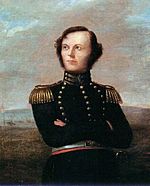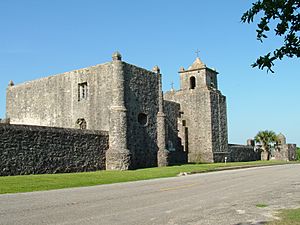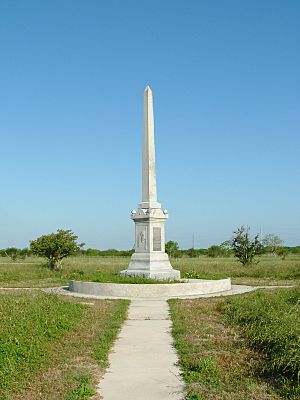Battle of Coleto facts for kids
Quick facts for kids Battle of Coleto ( Battle of Coleto Creek) |
|||||||
|---|---|---|---|---|---|---|---|
| Part of Texas Revolution, and the Goliad campaign | |||||||
 James Fannin, commander of Texian forces during the Battle of Coleto. |
|||||||
|
|||||||
| Belligerents | |||||||
| Republic of Texas | |||||||
| Commanders and leaders | |||||||
| José de Urrea | James Fannin (POW) | ||||||
| Strength | |||||||
| 19th: 80 cavalrymen, 260 infantrymen, 20th: 700-1,000 men |
400 men, 9 cannons |
||||||
| Casualties and losses | |||||||
| 10 killed, 65 wounded or missing | •At least 10 killed, 67 wounded during the battle •The rest were captured and then killed at the Goliad Massacre |
||||||
The Battle of Coleto, also known as the Battle of Coleto Creek, was an important fight during the Texas Revolution. It happened on March 19–20, 1836. This battle was part of the Goliad campaign, where Mexican forces tried to take control of the Goliad area in Texas.
In February 1836, General José de Urrea led a part of the Mexican army along the Gulf Coast of Mexican Texas. His goal was to reach Goliad, where a large group of Texian soldiers were stationed. These Texian soldiers were led by Colonel James W. Fannin. At the same time, Mexican president Santa Anna led a bigger army into Texas. On March 6, Santa Anna's troops won the famous Battle of the Alamo.
After hearing that the Alamo had fallen, Texian General Sam Houston ordered Fannin to leave Goliad. Fannin was told to join the rest of the Texian army in Victoria.
On March 19, Fannin and his men began their retreat from Goliad. They moved slowly. Later that day, Mexican troops surrounded the Texians. Fannin's men were still some distance from the safety of a wooded area at Coleto Creek. The Texians quickly formed a square shape in the middle of the open prairie to defend themselves. The Mexican troops attacked the square three times, but they could not break through the Texian lines.
As night came, Mexican sharpshooters (skilled shooters) were able to hit and wound more Texians. The Texians had very little water. They needed water for their wounded and to cool their cannons. Because of this, they felt they could not keep fighting. On the morning of March 20, the Texians surrendered. General Urrea tried to get good terms for the Texian prisoners. However, Santa Anna had ordered that all captured Texian soldiers be treated as pirates, not as regular prisoners of war. This meant they would not be protected by normal war rules. Despite Urrea's pleas, Santa Anna's orders led to the Goliad Massacre.
Contents
Why the Battle Happened
Colonel James Fannin was in charge of the Texan soldiers at Fort Defiance in late 1835 and early 1836. In February 1836, during the siege of the Alamo, Fannin tried to march about 100 miles to help the Texan forces there. But he was not ready for the long trip. He also heard that General Urrea's Mexican forces were coming towards Goliad. So, Fannin turned back.
After Santa Anna's army took the Alamo, General Sam Houston told the Texians to move back to Victoria. Fannin left Fort Defiance, but he did not have enough supplies. He also did not hurry his retreat.
Getting Ready for Battle
On March 19, at 9:00 AM, Fannin's troops started their retreat from Goliad. It was a very foggy morning. The Texian force included different groups of soldiers, like the San Antonio Greys and the Red Rovers. They also had nine heavy cannons and 1,000 muskets. However, Fannin forgot to make sure they had enough food and water.
Heavy carts were pulled by tired and hungry oxen. General Urrea did not realize the Texians had left until 11:00 AM. The Texians' two-hour head start was lost because of several problems. First, a Texian cart broke while crossing the San Antonio River. A cannon had to be pulled out of the river. Then, Fannin ordered the oxen to graze for a while after they had gone about a mile past Manahuilla Creek. This stopped the retreat.
Some of Fannin's officers, like John Shackelford, disagreed with this decision. They wanted to keep moving until they reached the safety of the Coleto Creek woods. Shackelford later said that Fannin believed the Mexican army was not very good and that Urrea would not follow them closely.
To catch Fannin's troops, Urrea left his cannons and some men in Goliad. He started chasing them with about 80 cavalrymen (soldiers on horseback) and 360 infantrymen (soldiers on foot). Mexican scouts on horseback found the Texians and reported how many there were. Urrea realized the Texian force was smaller than he thought. So, he sent 100 of his soldiers back to Goliad to help guard Presidio La Bahía. He also ordered the cannons he left behind to be brought to him.
Meanwhile, Albert C. Horton and his 30 cavalrymen were acting as guards for the Texian force. They were positioned around all sides of the Texians. But the rear guard was not alert. They did not see the Mexican cavalry approaching. Soon after the Texians started moving again, another cart broke down. Its cargo had to be moved, causing another delay.
Fannin sent Horton to scout the Coleto Creek woods, which were now in sight. Then, the Mexican cavalry caught up to Fannin's Texians. As the Texians tried to reach higher ground, about 400 to 500 yards away, their ammunition cart broke.
The Battle Begins
The Texian soldiers quickly formed a square shape to defend against the Mexicans. The tall grass on the prairie made it hard for the Texians to see the Mexican soldiers clearly. The Texians had very little water. Each Texian soldier had three or four muskets. The square was three lines deep. The San Antonio Greys and Red Rovers were in the front line. Duval's Mustangs and Frazer's Refugio militia were in the back. Westover's regulars covered the left side, and the Mobile Greys protected the right. Cannons were placed at the corners of the square. Fannin stood at the back of the right side. Some sharpshooters were also placed around Abel Morgan's hospital wagon. This wagon could not be moved because the ox pulling it was killed by Mexican fire.
The Mexican soldiers then attacked the square. On the left side of the Texian square, rifle companies attacked. On the right side, grenadiers and part of the San Luis Battalion attacked. General Urrea himself was watching this attack on the right. The Jiménez Battalion fought the front of the square. Cavalry soldiers were ordered to attack the rear.
By sunset, Urrea ordered the Mexicans to stop their major attacks. They were running low on ammunition. The Mexicans had attacked the square three times. Each time, the Texians used their bayonets (knives on rifles), many muskets, and nine cannons to stop the Mexicans from breaking their square. Urrea was impressed that the Texians had kept their square formation against three attacks. He also praised their accurate gunfire.
Dr. Joseph H. Barnard, a Texian, wrote that by sunset, seven Texians had been killed. He also recorded that sixty Texians, including Fannin, were wounded. Forty of the wounded had been hit multiple times.
After sunset, Urrea ordered Mexican sharpshooters to hide in the tall grass around the square. They fired at the Texians. Before Texian sharpshooters could stop them, the Mexican sharpshooters caused more Texian injuries. They fired at the flash of the Mexican guns to find them. By the end of March 19, at least ten Texians were dead and sixty were wounded. The Mexicans also had many casualties.
The fighting on March 19 did not make the Texian soldiers lose hope. They thought that Horton would get Texian reinforcements from Guadalupe Victoria to help Fannin. However, Horton had not been able to get through the Mexican defenses. During the day's fighting, Texian soldiers who were retreating to Guadalupe Victoria after the earlier battle of Refugio were close enough to Fannin to hear gunfire. But they were very tired and hungry and did not move to help the square. Urrea placed three groups of Mexican troops around the square to stop the Texians from escaping. During the night, Mexican bugle calls were sounded to keep the Texians awake and alert.
The Texians had no water, and they could not light fires in the square. This meant the wounded Texians could not be treated. The pain of the wounded soldiers made the Texian soldiers' spirits drop during the night. The bad weather during the night also made them feel worse. The lack of water also meant that the cannons could not be used well the next day. Water was needed to cool and clean the cannons. Many Texian cannon operators were also injured during the fighting on March 19. They also had little ammunition for the cannons.
All these problems led Fannin and his officers to decide that they could not fight another day. They thought about escaping to a better defensive spot in the dark, before Urrea got more soldiers. But they decided not to leave behind their injured friends and family. So, they decided to try to make another stand from their current position the next day. During the night, the Texians dug trenches and built barricades using carts and dead animals.
Meanwhile, Urrea received more supplies, fresh troops, and two or three cannons from Goliad. He placed the Mexican cannons on the hills overlooking the Texian square.
At 6:15 AM on March 20, the Mexicans were ready for battle. After one or two rounds were fired by the Mexican cannons, Fannin and his officers again decided that the Texians could not fight another day. They chose to surrender under honorable terms. They wrote down their surrender terms. These terms included that the wounded Texians would be treated. They also asked to be protected as prisoners of war and to be sent back to the United States of America.
However, Santa Anna had said earlier that any Texian could only surrender without any conditions. So, Urrea could not promise that Santa Anna would follow all the terms. He said he would talk to Santa Anna about the Texians' surrender terms. The surrender document was signed by Benjamin C. Wallace, Joseph M. Chadwick, and Fannin. After the signing, the Battle of Coleto ended.
What Happened Next
The Texians who could walk were sent to Goliad with Mexican guards. It took until about March 23 to transport the Texians who could not walk to Goliad. During that time, Mexican doctors were told to treat wounded Mexican soldiers first, before the wounded Texians. Fannin arrived in Goliad on March 22.
Urrea, meanwhile, had moved on to Guadalupe Victoria. From there, he wrote a letter to Santa Anna. He suggested that the Texian prisoners should be treated with kindness. However, Santa Anna did not follow Urrea's advice. Instead, he ordered the Mexican commander at Goliad, Jose Nicolas de la Portilla, to execute the Texian prisoners.
On Palm Sunday, March 27, 1836, Fannin and about 340 other Texian prisoners were shot by Mexican soldiers. This event became known as the Goliad Massacre.
The Battle of Coleto was important because it showed that the Texian troops, even though they were not very well trained, could stand up to the Mexican army and follow their commanders. The battle was mainly lost because Fannin did not act quickly enough to ensure success. He also did not realize how strong the Mexican force against him was. The battle also showed that Fannin, like many Texian commanders, did not want to work closely with other Texian forces.
See also
 In Spanish: Batalla de Coleto para niños
In Spanish: Batalla de Coleto para niños
Images for kids






